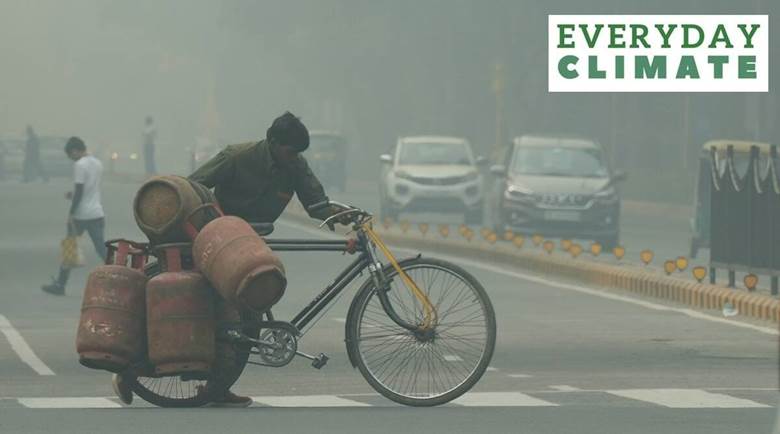Description

Copyright infringement not intended
Context: With the Nation Capital Region’s air quality deteriorating to hazardous levels, the Commission for Air Quality Management (CAQM) invoked measures under Stage 4 of the Graded Response Action Plan (GRAP) with immediate effect.
Details:
- A release issued by the CAQM said the measures were being taken “in the wake of unfavourable meteorological conditions anticipated to deteriorate the air quality of the NCR in the coming days.”
- Data from the System of Air Quality and Weather Forecasting And Research (SAFAR) showed that the Air Quality Index (AQI) continued to remain in the “severe” category.

What is the Graded Response Action Plan?
- GRAP is a set of emergency measures that kick in to prevent further deterioration of air quality once it reaches a certain threshold in the Delhi-NCR region.
- Approved by the Supreme Court in 2016 and notified in 2017, the plan was formulated after several meetings that the Environment Pollution (Prevention and Control) Authority (EPCA) held with state government representatives and experts.
- The result was a plan that institutionalised measures to be taken when air quality deteriorates.
- GRAP is incremental in nature and thus, when the air quality dips from ‘poor’ to ‘very poor,’ measures listed under both sections have to be followed.
- Stage 1 of GRAP is activated when the AQI is in the ‘poor’ category (201 to 300),
- Stage 2 is when it’s in the ‘Very poor’ category (301-400),
- Stage 3 is when the AQI is the ‘Severe’ category (401-450) and finally
- Stage 4 is when it rises to the ‘Severe +’ category (more than 450).
What is the current level of pollution in Delhi?
- As the AQI in NCR dipped to the ‘severe’ category, stage 4 of GRAP was set in motion.
- A central panel directed authorities to prohibit the use of diesel four-wheelers that are not BS-VI compliant, as well as the entry of trucks in Delhi. Petrol cars can continue to ply as usual.
- The BS or Bharat Stage emission standards are instituted by the government to regulate the output of air pollutants from motor vehicles from internal combustion engine equipment.
- The BS-VI fuel was estimated to bring around an 80 per cent reduction of sulphur, from 50 parts per million to 10 ppm.
- The ban on diesel four-wheelers, except BS-VI vehicles and those used for essential and emergency services, will be applicable in Delhi and NCR districts bordering the capital, according to the order.
- Additionally, all industries in the NCR running on fuels apart from those approved for the NCR are to be shut, except for dairy units and those manufacturing medical equipment or drugs.
- Construction and demolition activities, including those on linear public projects like highways, roads, flyovers, pipelines and power lines, which were previously allowed to continue, will also be banned.
- Delhi schools will also be closed for students up to class five. While offline sessions will continue for those in classes 6 to 12, all types of outdoor activities will be discontinued.
How is GRAP different this year?
- The CAQM revised the GRAP earlier this year.
- The GRAP was first notified in January 2017 by the Ministry of Environment, Forest and Climate Change. This was based on a plan submitted by the Central Pollution Control Board (CPCB) in November 2016.
- According to the notification, the task of implementing the GRAP fell on the now-dissolved Environment Pollution (Prevention and Control) Authority for the NCR. From 2021 onwards, the GRAP is being implemented by the CAQM.
- While previously, measures were introduced after pollution concentrations reached a certain level, this year, measures are pre-emptively introduced and will kick in based on forecasts in an attempt to prevent the air quality from deteriorating further. For this, the CAQM relies on air quality and meteorological forecasts by the Indian Institute of Tropical Meteorology (IITM) and the India Meteorological Department (IMD).
- The older version of the GRAP was enforced based only on the concentration of PM2.5 and PM10. This year, GRAP is being enforced based on the AQI, which takes other pollutants also into account, such as ozone, sulphur dioxide and oxides of nitrogen.
What happens next?
- The government was contemplating bringing back the odd-even scheme
- Stubble emissions with a fire count of 2,994 contributed 34 per cent to PM2.5 in Delhi.
- Fine particles (size <2.5 micrometres) contributed to 66 per cent of PM10. Local surface winds are 10 to 12 km per hour for the next three days which can cause moderate dispersion of pollutants.
https://indianexpress.com/article/explained/everyday-explainers/what-is-grap-delhi-ncr-action-plan-to-combat-rising-air-pollution-8250061/
















